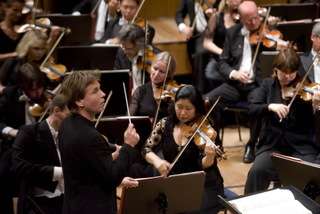|
Back
Lightness and Shade, Summer Winds and Distant Cowbells Lucerne
Kultur Kongresszentrum Luzern
08/24/2009 -
Kaija Saariaho: Lumière et Pesanteur
Anton Webern: Im Sommerwind
Gustav Mahler: Symphony No. 6 “Tragic”
Philharmonia Orchestra, Esa-Pekka Salonen (conductor) 
Esa-Pekka Salonen (© Priska Ketterer)
The Finnish composer Kaija Saariaho is composer-in-residence at this summer’s Lucerne Festival and her works are sprinkled throughout the Festival’s concerts. This was the Swiss premiere of Lumière et Pesanteur after the work’s first performance recently in Helsinki. It was indeed an interplay of delicate light and tragic weight, not displeasing on the ear but with so little apparent structure that it failed to hold the concentration or be memorable, once one had heard the Webern and been battered by the Mahler. Difficult acts to precede, one must admit.
Webern’s Im Sommerwind is a delightful and masterly early work. It was fascinating to hear an early work by a composer who eventually became a musician of great originality. The work was written when Webern was only 20, and includes evidence of influences (particularly Richard Strauss) on his formative years. Anyone suspecting to hear atonality was surprised to hear a luxuriantly romantic tonal and quite traditional work. However, there is an undercurrent which gives the work an unusual and memorable quality. Its delicate features were tenderly coaxed and caressed by Salonen and the orchestra relished its languor. But more Weber than Webern really.
Without an interval and hardly a pause for breath, Salonen launched straight into the opening march of Mahler’s Symphony No. 6 . Surprisingly, Salonen’s approach and rather bouncy conducting style led to a lack of some aggression and the necessary degree of rawness, preferring at times to smooth over elements of any angular modernity. Mahler’s nervosity did however come to the fore in the Scherzo which Salonen chose to play as the second movement. Mahler never actually conducted his Sixth Symphony with the middle-movement order Scherzo-Andante, nor did he instruct anyone else to do so. The argument on the sequence of the two inner movements rumbles on, as does the inclusion of the third hammer blow (which Salonen, as most conductors nowadays, elected to omit) in the final movement.
There was fine playing throughout from arguably the finest London orchestra, the Philharmonia (admirers of the London Symphony Orchestra may disagree), forceful and accurate brass, full-bodied and warm strings, fine horn playing from Nicholas Busch, the hard and exact thwack of the timpani from their longstanding and outstanding principal timpanist Andrew Smith, and fine contributions from both the principal flute and clarinet.
Whether the cowbells were on a nearby Alpine pasture or not, they were nigh inaudible – as usual, sadly, in most performances of Mahler 6. Only studio recordings manage to bring them properly to the fore.
Salonen moved the whole work on briskly, sometimes perhaps too much so, and occasionally failed to explore the darker depths of the piece, preferring to showcase his excellent orchestra. The orchestra have played this piece several times over recent months and the final Coda was honed to absolute and majestic perfection.
The Philharmonia Orchestra
John Rhodes
|